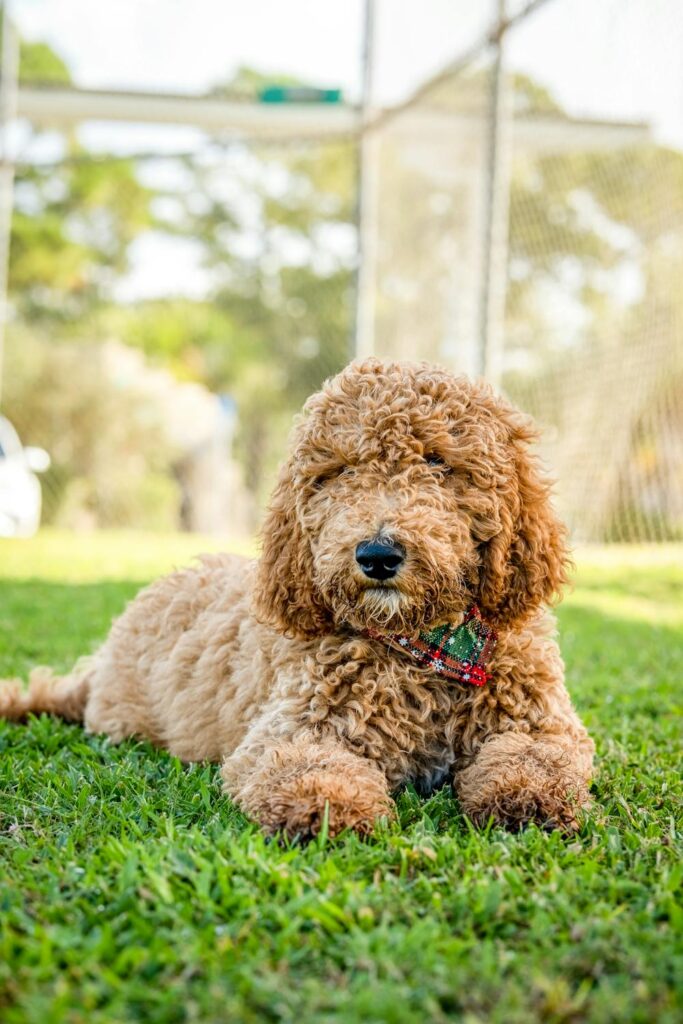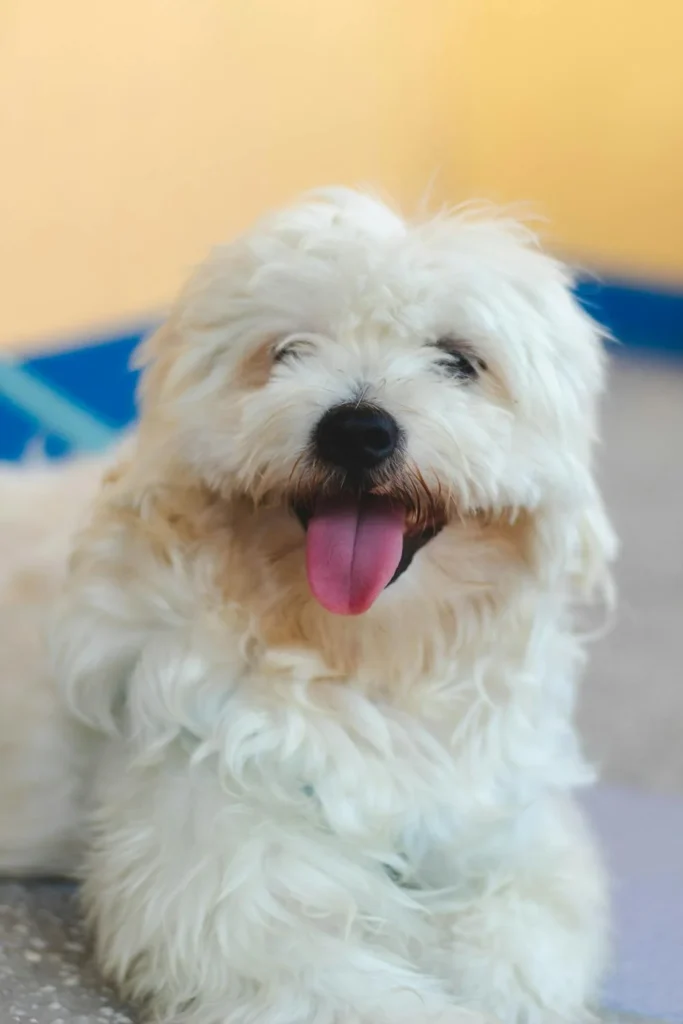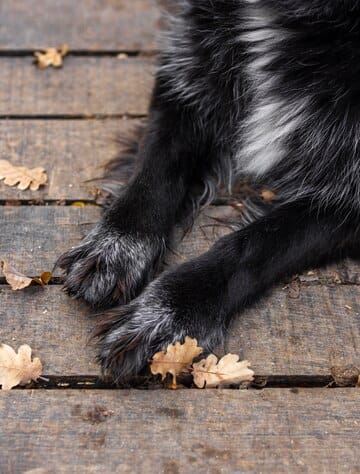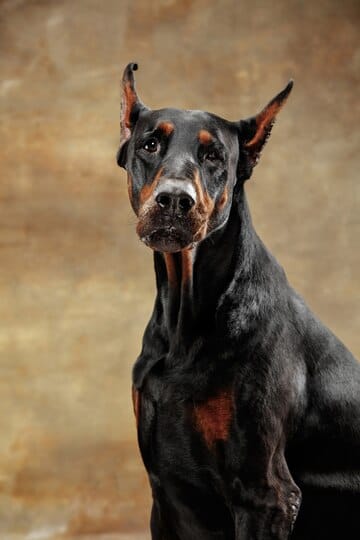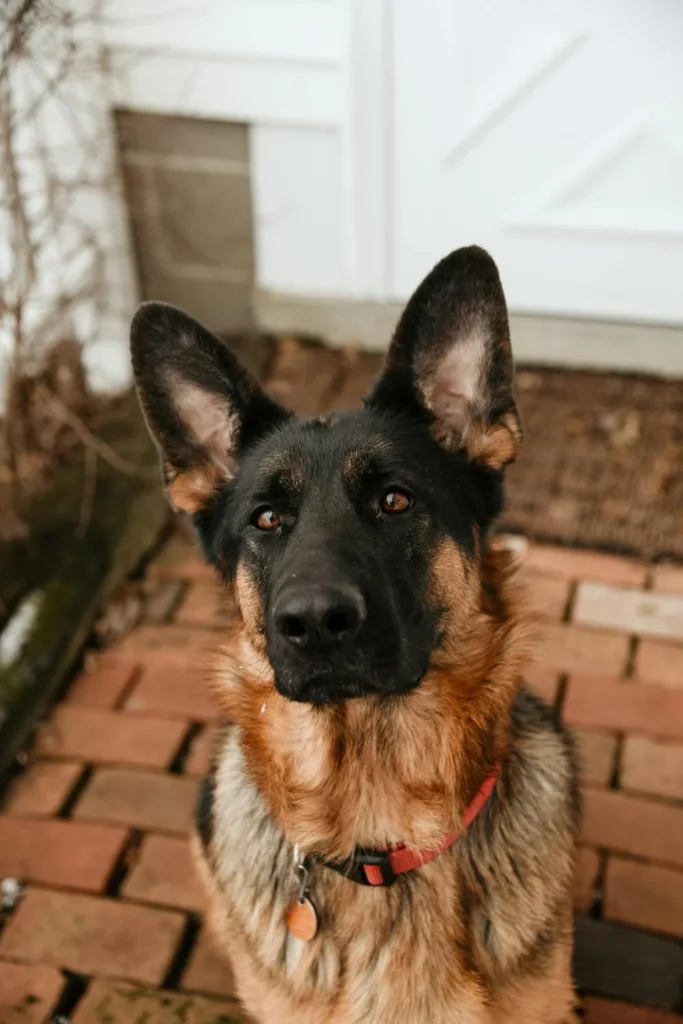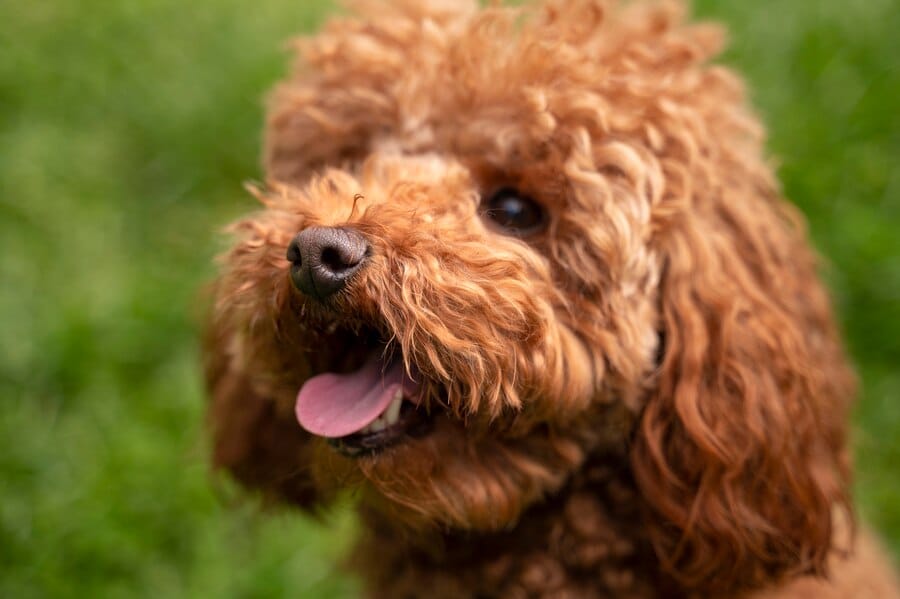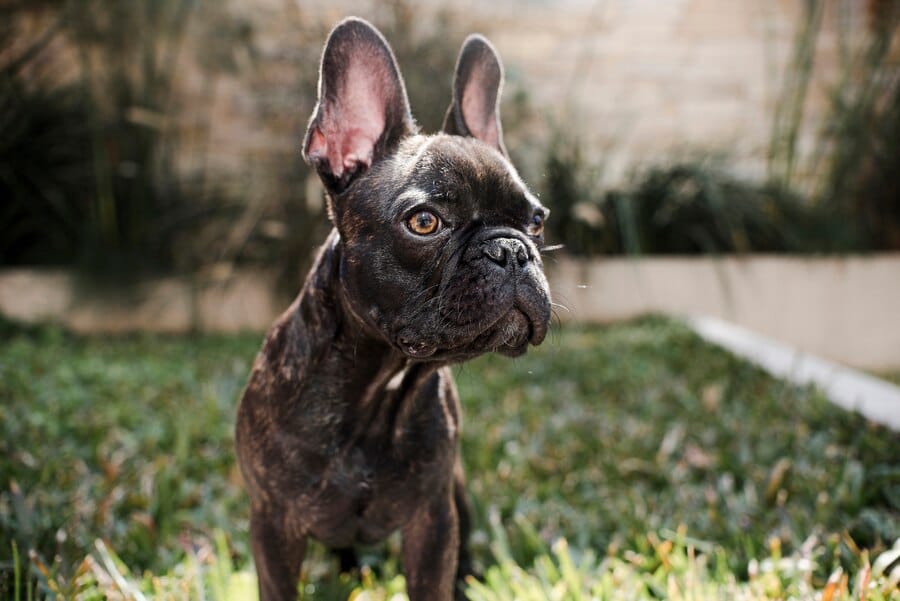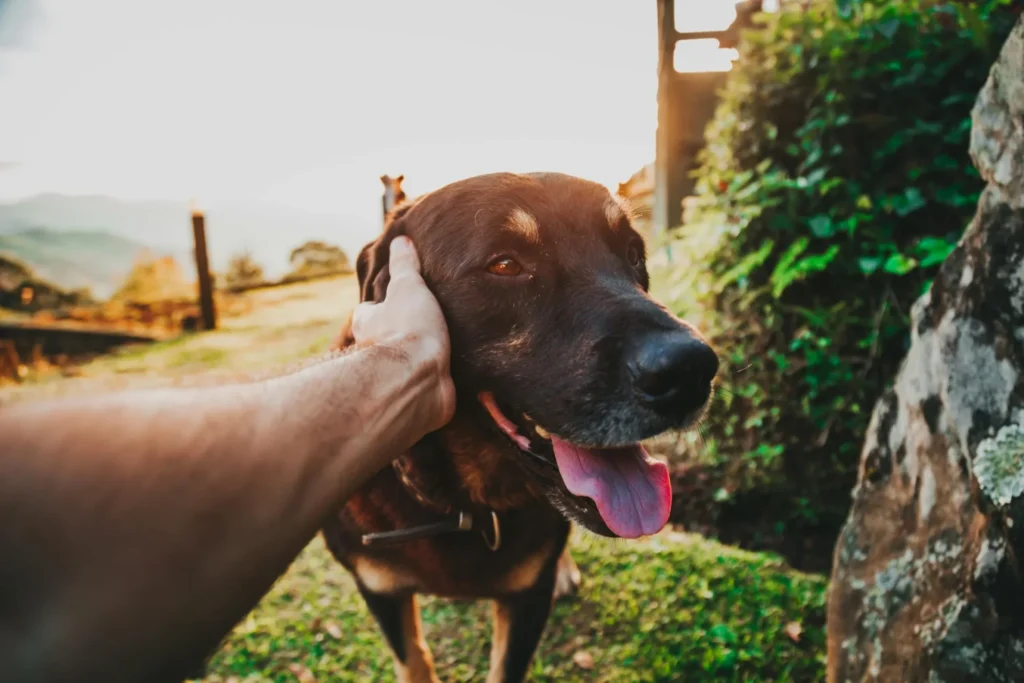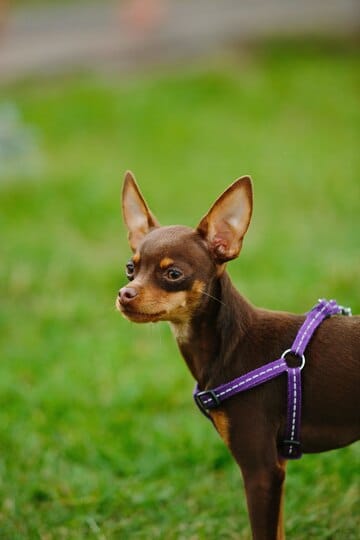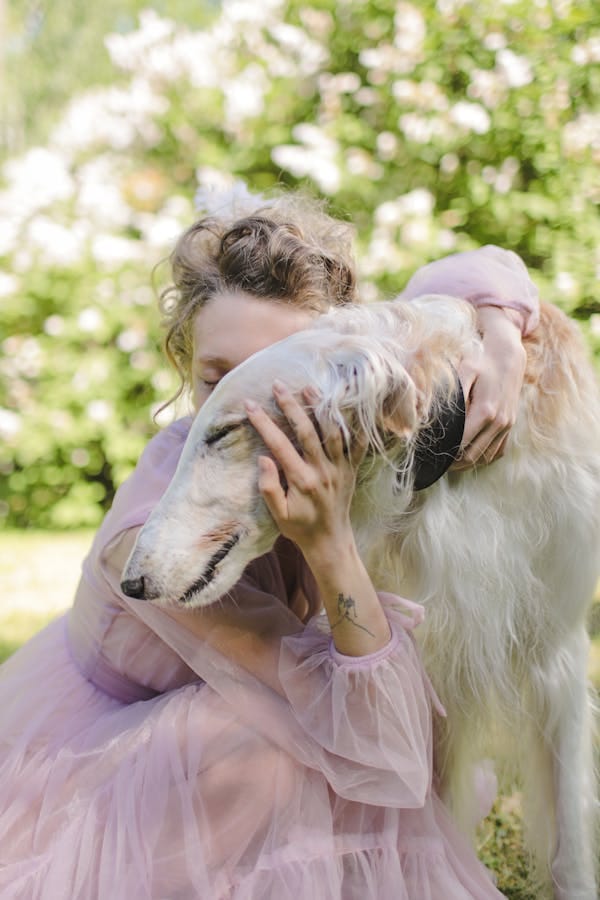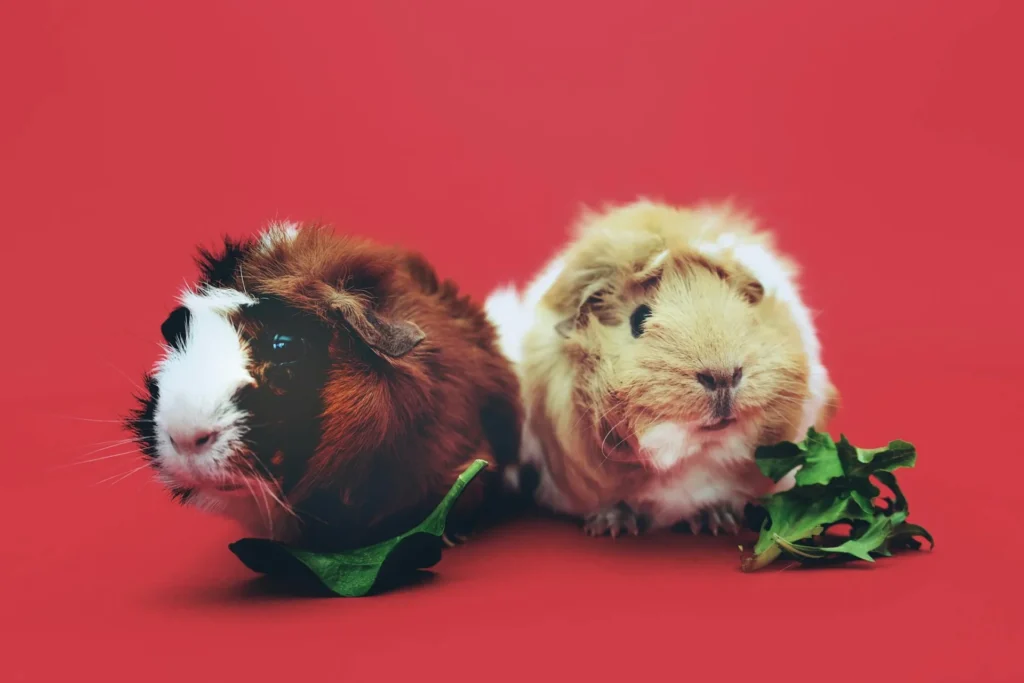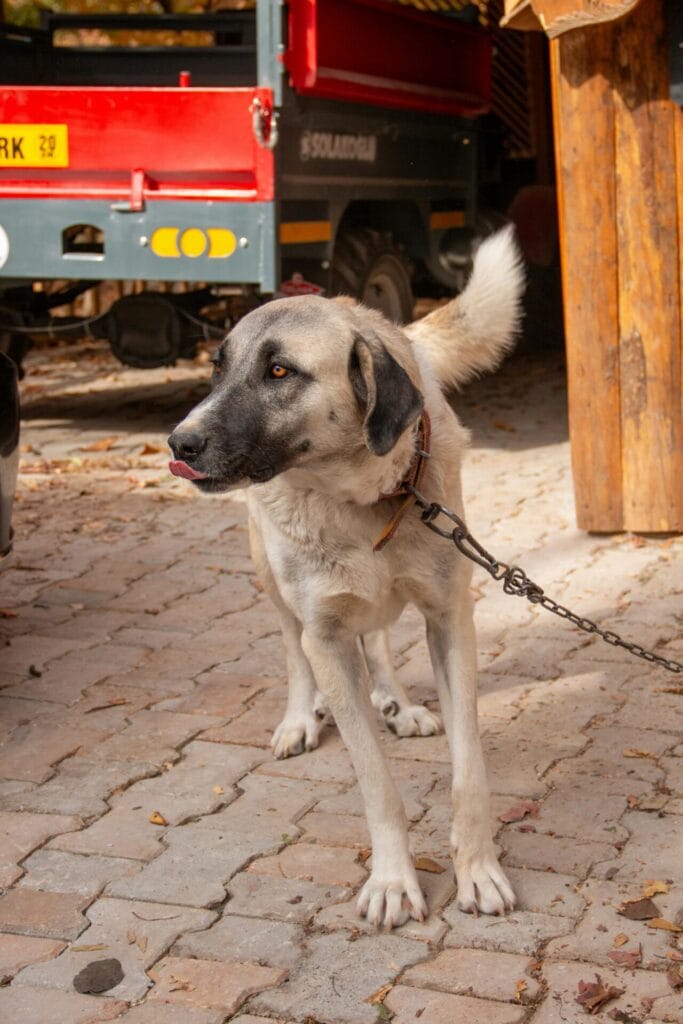- Introduction
- Origins and History
- Breed Characteristics
- Appearance
- Temperament
- Living Needs
- Group
- Characteristics
- Coat Type and Shedding Levels
- Trainability
- Caring for Your Aussiedoodle
- Grooming Routine and Coat Maintenance
- Exercise and Mental Stimulation: Keeping Your Aussiedoodle Happy and Healthy
- Training Tips: Unleashing Your Aussiedoodle’s Full Potential
- Nutrition and Feeding Guidelines: Fueling Your Aussiedoodle’s Active Lifestyle
- Suitability for First-Time Owners: Is the Aussiedoodle the Right Choice for You?
- Health Matters
- Pros and Cons of Owning an Aussiedoodle
- Who Is the Aussiedoodle Most Suitable For?
- Fun Facts and Trivia
- Getting an Aussiedoodle Puppy
- A Day in the Life
- Conclusion
- Frequently Asked Questions
Introduction
Prepare to be enchanted by the irresistible charm of the Aussiedoodle, a delightful hybrid breed that has taken the dog world by storm. This exuberant and affectionate companion is the result of crossing the highly intelligent Australian Shepherd with the beloved and hypoallergenic Poodle, creating a unique blend of energy, intelligence, and an endearing appearance that’s hard to resist.

Breed Overview and Key Highlights
The Aussiedoodle is a relatively new hybrid, but its popularity has skyrocketed in recent years, captivating dog lovers worldwide with its versatility and remarkable traits. Known for their boundless energy, eager-to-please attitudes, and an affinity for adventure, these furry companions make excellent family pets, excelling in various roles from devoted companions to skilled agility and therapy dogs. With their hypoallergenic coats and diverse range of sizes, Aussiedoodles offer a perfect match for a wide range of lifestyles and living situations.
Origins and History
Tracing the Roots: The Aussiedoodle’s Fascinating Backstory
The Aussiedoodle’s origins can be traced back to the late 20th century when breeders sought to combine the best traits of the Australian Shepherd and the Poodle. The goal was to create a hybrid that would inherit the intelligence, energy, and herding instincts of the Australian Shepherd, along with the hypoallergenic coat and affectionate nature of the Poodle, making it an ideal companion for active families and individuals with allergies.
From Working Dog to Beloved Pet: The Evolution of the Aussiedoodle
Both the Australian Shepherd and the Poodle have rich histories as working dogs, excelling in tasks such as herding, guarding, and retrieving. However, as their remarkable traits and loyal personalities became more widely appreciated, they transitioned into cherished family companions. The Aussiedoodle has followed suit, combining the best of both worlds – the energy and intelligence of a hardworking herder with the affectionate and people-pleasing nature of a beloved pet.
Breed Characteristics
Distinctive Traits of the Aussiedoodle
The Aussiedoodle is a breed that truly stands out from the crowd. With their lively expressions, boundless energy, and a coat that ranges from soft and wavy to tightly curled, these hybrid pups are a sight to behold. Their size can vary depending on the specific parent breed mix, but their friendly, affectionate, and eager-to-please nature remains a constant.
Quick Facts and Need-to-Know Points
| Fact | Description |
|---|---|
| Height | 10-24 inches |
| Weight | 15-70 pounds |
| Coat | Soft, wavy, or curly; hypoallergenic |
| Lifespan | 10-15 years |
| Energy Level | High |
| Trainability | Highly intelligent and eager to learn |
| Shedding | Minimal to non-shedding |
| Grooming Needs | Regular brushing and professional grooming |
| Temperament | Affectionate, loyal, energetic, and playful |
Appearance
The Look of Elegance: Unraveling the Aussiedoodle’s Unique Appearance
The Aussiedoodle’s appearance is a delightful fusion of their parent breeds, resulting in a distinctive and captivating look. Their expressive eyes and floppy ears add to their endearing charm, while their coats can range from soft and wavy to tightly curled, often featuring a stunning array of colors, including shades of black, blue, red, and merle.

Physical Characteristics and Size Variations
Aussiedoodles can vary significantly in size depending on the specific parent breed mix, with heights ranging from 10 to 24 inches and weights between 15 and 70 pounds. Their compact and sturdy build ensures they are agile and energetic companions, ready for adventure and activity.
A Coat Like No Other: Exploring Coat Types and Colors
One of the Aussiedoodle’s most remarkable features is their coat, which can range from soft and wavy to tightly curled, with a variety of colors and patterns, including solid shades, parti-colors (a combination of two colors), and the distinctive merle pattern inherited from the Australian Shepherd parent. Their hypoallergenic coats make them an excellent choice for those with allergies, as they shed minimally or not at all.
Grooming Needs: Keeping Your Aussiedoodle Looking Their Best
Aussiedoodles require regular grooming to maintain their beautiful coats and prevent matting. Weekly brushing and occasional professional grooming are recommended, along with regular baths and trimming of their fast-growing nails. Proper grooming not only keeps your Aussiedoodle looking their best but also helps to maintain their coat’s health and prevent skin irritations.
Temperament
The Delightful Personality of the Aussiedoodle
The Aussiedoodle’s temperament is a true delight, combining the energy and intelligence of the Australian Shepherd with the affectionate and loyal nature of the Poodle. These exuberant companions have an innate desire to please their owners, making them highly responsive to training and eager to learn new tricks and commands.
Their friendly nature and adaptability make them excellent family pets, as they thrive on human companionship and love being part of the action. However, their high energy levels and intelligence also mean they require plenty of mental and physical stimulation to prevent boredom and destructive behaviors.
Energy Levels and Exercise Needs
Aussiedoodles are known for their boundless energy and enthusiasm, making them ideal companions for active individuals or families. Regular exercise, such as daily walks, hiking, or playtime in a securely fenced area, is essential to keep them physically and mentally stimulated.

Their exercise needs can vary based on their size and the traits inherited from their parent breeds, but most Aussiedoodles require at least 60-90 minutes of moderate to vigorous exercise daily to maintain their physical and mental well-being.
Socialization and Training: Unlocking Your Aussiedoodle’s Full Potential
Proper socialization and training from an early age are crucial for Aussiedoodles to reach their full potential. Their eagerness to please and high intelligence make them quick learners, but it’s important to use positive reinforcement techniques and make training sessions fun and engaging. Early socialization helps them develop confidence and adapt well to various situations and environments.
Living Needs
The Perfect Companion: Is the Aussiedoodle Right for Your Lifestyle?
Aussiedoodles are incredibly adaptable companions, but they thrive best in active households where their exercise and mental stimulation needs can be met. Their boundless energy and affinity for outdoor adventures make them an excellent choice for active individuals or families who enjoy hiking, running, or participating in dog sports.
While their moderate size and generally friendly nature make them suitable for apartment living, it’s essential to provide them with ample exercise and mental stimulation to prevent boredom and destructive behaviors.
Exercise Requirements: Keeping Your Aussiedoodle Active and Engaged
Aussiedoodles require a significant amount of exercise to maintain their physical and mental well-being. Daily walks, playtime in a securely fenced area, and interactive games or puzzle toys are essential to keep them physically and mentally engaged.
Providing your Aussiedoodle with a variety of activities, such as agility training, hiking, swimming, or dog sports, can help meet their exercise and mental stimulation needs while strengthening the bond between you and your furry companion.
Apartment-Friendly or Countryside Dweller? Exploring Suitable Living Conditions
While Aussiedoodles can adapt to apartment living, they thrive in environments with access to outdoor spaces for exercise and exploration. They do well in both urban and rural settings, as long as their exercise and socialization needs are met.
However, it’s important to ensure they receive proper training and socialization to prevent excessive barking or destructive behaviors when left alone for extended periods. Providing them with mental stimulation and interactive toys can also help.
Companionship and Separation Anxiety: Understanding Your Aussiedoodle’s Needs
Aussiedoodles are highly social and thrive on human companionship, which means they may experience separation anxiety if left alone for too long. It’s important to gradually introduce them to being alone and provide them with plenty of mental stimulation and interactive toys to keep them occupied. Crate training and doggy daycare can also help alleviate separation anxiety when their owners are away for extended periods.
Group
The Aussiedoodle does not have an official breed club or kennel club classification, as it is a hybrid breed. However, their parent breeds, the Australian Shepherd and the Poodle, belong to the Herding and Non-Sporting groups, respectively.
Activity Level
From Couch Potato to Energetic Dynamo: The Aussiedoodle’s Activity Spectrum
Aussiedoodles are undoubtedly an energetic breed, with high activity levels that make them well-suited for active households and outdoor adventures. Their boundless energy and enthusiasm stem from their ancestry as working dogs, combined with the playful nature of the Poodle.
While some Aussiedoodles may be slightly more laid-back than others, most require a significant amount of daily exercise and mental stimulation to prevent boredom and destructive behaviors. Providing them with a variety of activities, such as agility training, hiking, swimming, or dog sports, can help channel their energy in a positive and productive way.
Barking Level
The Silent Sentinel or Vocal Vigilante: Understanding Your Aussiedoodle’s Barking Tendencies
Aussiedoodles are not typically known as excessive barkers, but their barking tendencies can vary based on their individual personalities and training. Some Aussiedoodles may be more vocal, barking to alert their owners of potential dangers or to seek attention, while others may be more reserved and bark only when necessary.
Proper training and socialization from an early age can help curb excessive barking and teach your Aussiedoodle when it is appropriate to vocalize. It’s important to address any underlying causes of excessive barking, such as boredom, separation anxiety, or a lack of exercise and mental stimulation.
Characteristics
The Aussiedoodle’s Unique Quirks and Endearing Traits
Aussiedoodles are known for their vibrant and endearing personalities, which often include a range of quirky and lovable traits. From their boundless energy and goofy expressions to their affectionate nature and desire for human companionship, these hybrid pups are sure to steal your heart.
Some Aussiedoodles may exhibit a strong herding instinct, inherited from their Australian Shepherd lineage, making them prone to nipping at heels or trying to “herd” family members. Others may have a strong affinity for water, thanks to their Poodle heritage, and may enjoy activities like swimming or playing in sprinklers.
Regardless of their individual quirks, one thing is certain: Aussiedoodles are sure to bring joy, laughter, and endless entertainment into your life with their lovable and exuberant personalities.
Coat Type and Shedding Levels
Exploring the Aussiedoodle’s Coat Varieties
One of the most distinctive features of the Aussiedoodle is their coat, which can range from soft and wavy to tightly curled, depending on the specific genetic mix of their parent breeds. Their coats are typically low to non-shedding, making them an excellent choice for those with allergies or a preference for a more hypoallergenic companion.
| Coat Type | Description |
|---|---|
| Wavy | A soft, gently waved coat, resembling the Poodle’s coat. |
| Curly | A tightly curled, almost poodle-like coat, inherited from the Poodle parent. |
| Combination | A blend of both wavy and curly textures, creating a unique and charming coat. |
Aussiedoodles may also inherit a range of coat colors and patterns, including solid shades, parti-colors (a combination of two colors), and the distinctive merle pattern from the Australian Shepherd parent, adding to their unique and captivating appearance.
The Aussiedoodle’s Shedding Levels
One of the most appealing aspects of the Aussiedoodle breed is their low to non-shedding coats, making them an excellent choice for those with allergies or a preference for a more hypoallergenic companion. While their shedding levels may vary based on their specific genetic makeup, most Aussiedoodles are considered minimal to non-shedders.
Regular grooming and brushing can help to minimize any shedding that may occur, as well as prevent matting and keep their coats looking their best. However, it’s important to note that no dog breed is truly hypoallergenic, as dander and saliva can still trigger allergies in some individuals.
Trainability
Unleashing the Potential: The Aussiedoodle’s Trainability and Intelligence
Aussiedoodles are highly intelligent and eager to please, making them excellent candidates for training. Their Australian Shepherd heritage endows them with a keen intellect and a strong work ethic, while their Poodle lineage contributes to their willingness to learn and their desire to please their owners.
Positive reinforcement training techniques, such as reward-based methods and clicker training, are highly effective with Aussiedoodles. Their quick learning abilities and adaptability make them suitable for various training disciplines, from basic obedience to more advanced activities like agility, obedience competitions, or therapy work.
Consistency, patience, and early socialization are key to unlocking the full potential of your Aussiedoodle’s trainability, ensuring a well-rounded and well-behaved companion.
Caring for Your Aussiedoodle
Grooming Routine and Coat Maintenance
Proper grooming is essential for maintaining the health and beauty of your Aussiedoodle’s coat. Regular brushing, at least two to three times a week, is recommended to prevent matting and remove loose hair. Depending on your Aussiedoodle’s coat type, they may require professional grooming every 6-8 weeks to keep their coat in top condition.
It’s important to introduce your Aussiedoodle to grooming routines from an early age, making the experience positive and stress-free. Regular nail trimming, ear cleaning, and dental care should also be part of their grooming routine to ensure their overall health and well-being.
Exercise and Mental Stimulation: Keeping Your Aussiedoodle Happy and Healthy
Aussiedoodles are highly active and energetic breeds that require significant daily exercise and mental stimulation to thrive. At least 60-90 minutes of moderate to vigorous exercise, such as walks, playtime in a securely fenced area, and interactive games or puzzle toys, is essential to keep them physically and mentally engaged.
Providing your Aussiedoodle with a variety of activities, such as agility training, hiking, swimming, or dog sports, can help meet their exercise and mental stimulation needs while strengthening the bond between you and your furry companion.
Training Tips: Unleashing Your Aussiedoodle’s Full Potential
Training your Aussiedoodle should be a positive and engaging experience for both you and your pup. Here are some helpful tips to unleash their full potential:
- Start training early: Aussiedoodles are quick learners, and early training helps establish good habits and a strong bond.
- Use positive reinforcement: Reward-based training techniques, such as clicker training and treats, are highly effective with Aussiedoodles.
- Keep sessions short and fun: Aussiedoodles have short attention spans, so keep training sessions brief (5-10 minutes) and incorporate play and praise.
- Be consistent: Consistency is key when training your Aussiedoodle, as they thrive on routine and clear expectations.
- Socialize early: Proper socialization from an early age helps Aussiedoodles develop confidence and adaptability in various environments.
Nutrition and Feeding Guidelines: Fueling Your Aussiedoodle’s Active Lifestyle
Proper nutrition is essential for your Aussiedoodle’s overall health and well-being. Choose a high-quality, age-appropriate dog food formula that meets their nutritional needs and high energy requirements. Aussiedoodles typically do well on a diet rich in protein and moderate in fat, with the appropriate balance of essential vitamins and minerals.
The amount of food your Aussiedoodle requires will depend on their age, activity level, metabolism, and size. It’s important to follow the recommended feeding guidelines on the dog food label and adjust portions as needed to maintain a healthy weight.
Always ensure that your Aussiedoodle has access to fresh, clean water at all times, and consider incorporating healthy treats and supplements as recommended by your veterinarian to support their active lifestyle and overall health.
Quick Feeding Tips:
- Feed a high-quality diet formulated for active or working dogs
- Split meals into 2-3 portions per day for better digestion
- Adjust portions based on age, activity level, and body condition
- Provide plenty of fresh water, especially after exercise
- Consider adding dog-safe supplements like glucosamine for joint health
Suitability for First-Time Owners: Is the Aussiedoodle the Right Choice for You?
Aussiedoodles can make wonderful companions for first-time owners, but it’s important to recognize the breed’s high energy levels, grooming needs, and training requirements. Their affectionate nature, intelligence, and eagerness to please make them highly trainable, but they also require a significant amount of time, patience, and commitment from their owners.
First-time owners should be prepared to provide daily exercise, mental stimulation, and proper socialization and training from an early age. Aussiedoodles thrive best in active households where their energy can be channeled into positive outlets, such as agility training, hiking, or dog sports.
If you’re a first-time owner considering an Aussiedoodle, it’s recommended to research the breed thoroughly, attend obedience classes, and seek guidance from experienced Aussiedoodle owners or breeders to ensure a successful transition into pet parenthood.
Health Matters
Average Lifespan: How Long Can You Expect Your Aussiedoodle to Live?
Aussiedoodles are generally considered a healthy and long-lived breed, with an average lifespan of 10 to 15 years. However, it’s important to note that their lifespan can be influenced by various factors, including genetics, diet, exercise, and overall health care.
Providing your Aussiedoodle with a balanced diet, regular exercise, and preventive health care, such as routine veterinary check-ups and recommended vaccinations, can help ensure they live a long and healthy life.
Potential Health Issues: What to Watch Out For
Like all breeds, Aussiedoodles can be prone to certain health issues. While not all Aussiedoodles will develop these conditions, it’s important to be aware of them and work closely with your veterinarian to monitor your furry companion’s health.
Here are some potential health concerns to be aware of in Aussiedoodles:
- Hip and Elbow Dysplasia: These are inherited conditions that can cause joint problems and arthritis. Reputable breeders should screen for these issues.
- Progressive Retinal Atrophy (PRA): A group of eye disorders that can lead to blindness. Genetic testing can identify affected dogs.
- Epilepsy: A neurological condition characterized by recurrent seizures. Proper medication and management are crucial.
- Addison’s Disease: An endocrine disorder that affects the adrenal glands, leading to insufficient hormone production.
- Allergies: Aussiedoodles may inherit allergies, either environmental or food-related, from their parent breeds.
- Bloat: A potentially life-threatening condition where the stomach twists and fills with gas. Deep-chested breeds are more prone to this.
It’s crucial to work with reputable breeders who screen for these conditions and provide health clearances. Regular vet check-ups, a balanced diet, and exercise can also help prevent or manage some of these issues.
The Importance of Health Clearances from Reputable Breeders
When looking for an Aussiedoodle puppy, it’s essential to work with reputable breeders who prioritize the health and well-being of their litters. Responsible breeders should provide documentation of health clearances for the parent dogs, which can help reduce the risk of hereditary conditions in your Aussiedoodle.
Health clearances may include:
- Hip and elbow evaluations
- Ophthalmologist evaluations for eye conditions like PRA
- Cardiac examinations
- DNA testing for specific genetic disorders
Reputable breeders will also be knowledgeable about the breed, provide socialization and early training for their puppies, and offer guidance and support throughout the process of selecting and caring for your new furry family member.
Vet Care and Preventive Measures: Keeping Your Aussiedoodle Healthy
Regular veterinary care is essential for maintaining your Aussiedoodle’s health and well-being. It’s recommended to schedule annual check-ups and follow your veterinarian’s recommendations for vaccinations, parasite prevention, and other preventive measures.
Some preventive measures to consider include:
- Flea, tick, and heartworm prevention
- Dental care and regular teeth cleanings
- Routine blood work and health screenings
- Maintaining a healthy weight through proper diet and exercise
By being proactive about your Aussiedoodle’s health care, you can help catch any potential issues early and take the necessary steps to keep your furry companion happy and healthy for years to come.
Pros and Cons of Owning an Aussiedoodle
Like any breed, owning an Aussiedoodle comes with its own set of advantages and disadvantages. Here’s a closer look at some of the pros and cons to consider:
Pros
- Affectionate and loyal companions
- Hypoallergenic coats, suitable for those with allergies
- Highly intelligent and easily trainable
- Adaptable to various living environments
- High energy levels, great for active families
- Relatively long lifespan (10-15 years)
- Versatile in various roles (e.g., agility, therapy work)
Cons
- Require significant daily exercise and mental stimulation
- May experience separation anxiety if left alone for extended periods
- Potential for inheriting health issues from parent breeds
- Higher initial cost compared to mixed-breed dogs
- Require professional grooming every 6-8 weeks
- May exhibit herding behaviors (e.g., nipping, chasing)
Weighing these pros and cons can help potential owners determine if an Aussiedoodle is the right fit for their lifestyle and needs.
Who Is the Aussiedoodle Most Suitable For?
Finding the Perfect Match: Is the Aussiedoodle Right for Your Lifestyle and Needs?
Aussiedoodles are incredibly versatile companions that can adapt to various lifestyles and living situations, but they thrive best in active households where their exercise and mental stimulation needs can be met. They make excellent family pets, thanks to their affectionate nature and ability to bond with children. Their moderate size and adaptability also make them suitable for apartment living, provided their exercise and socialization needs are met.
Active individuals or families who enjoy outdoor activities like hiking, running, or participating in dog sports may find the Aussiedoodle’s energy levels and eagerness to please a perfect match. However, those with a more sedentary lifestyle should carefully consider the breed’s exercise requirements before committing to an Aussiedoodle.
Aussiedoodles can also make wonderful therapy dogs or service animals due to their intelligence, trainability, and affectionate nature. Their hypoallergenic coats make them a good choice for those with allergies or a preference for a more allergy-friendly breed.
Ultimately, the suitability of an Aussiedoodle will depend on your lifestyle, activity level, living situation, and willingness to provide the necessary exercise, grooming, and training required for this energetic and intelligent breed.
Fun Facts and Trivia
- The Aussiedoodle’s name is a playful combination of “Aussie” (from the Australian Shepherd) and “Poodle.”
- These hybrids are sometimes referred to as “Aussiepoos” or “Aussie Poos” as well.
- Aussiedoodles come in a variety of colors and patterns, including solid shades, parti-colors, and the distinctive merle pattern inherited from the Australian Shepherd parent.
- While they are a relatively new breed, Aussiedoodles have quickly gained popularity as active family companions and talented competitors in dog sports like agility and obedience.
- The first known Aussiedoodle litter was born in the early 2000s, marking the beginning of this energetic hybrid breed.
- Aussiedoodles are often praised for their teddy bear-like appearance and cuddly coats, combined with their lively and energetic personalities.
- Some famous Aussiedoodle owners include celebrities like Amanda Seyfried and Jennifer Aniston.
Getting an Aussiedoodle Puppy
Finding Reputable Breeders: What to Look For
When searching for an Aussiedoodle puppy, it’s essential to work with reputable and responsible breeders. Here are some key factors to consider:
- Health Testing: Responsible breeders should provide documentation of health clearances for the parent dogs, including hip, elbow, eye, and genetic testing.
- Socialization and Early Training: Look for breeders who prioritize early socialization and basic training for their puppies, ensuring a well-adjusted and confident pup.
- Environment and Care: Reputable breeders should raise their litters in clean, safe, and loving environments, providing proper care and attention.
- Knowledge and Experience: Experienced breeders should have a deep understanding of the breed, its temperament, and specific care requirements.
- Contracts and Guarantees: Responsible breeders should provide contracts outlining the terms of sale, health guarantees, and any necessary agreements.
- References and Recommendations: Don’t hesitate to ask for references from previous buyers or seek recommendations from breed clubs or organizations.
By working with reputable breeders, you increase the chances of getting a healthy, well-adjusted Aussiedoodle puppy and can establish a supportive relationship with the breeder for guidance throughout your puppy’s life.
Cost of Purchasing an Aussiedoodle Puppy
The cost of purchasing an Aussiedoodle puppy can vary depending on several factors, including the breeder’s reputation, location, and the specific lineage of the puppy. On average, expect to pay anywhere from $1,000 to $3,000 for a well-bred Aussiedoodle puppy from a reputable breeder.
It’s important to remember that the initial cost of purchasing a puppy is just the beginning. Additional expenses, such as supplies (crate, bedding, toys), veterinary care (vaccinations, spaying/neutering), grooming, and training, should also be factored into your budget.
While the upfront cost may seem high, investing in a well-bred puppy from a responsible breeder can save you money in the long run by reducing the risk of inheriting health issues and ensuring a well-socialized and trained companion.
Rescues and Adoption: Providing Fur-ever Homes
In addition to purchasing a puppy from a breeder, another option to consider is adopting an Aussiedoodle from a reputable rescue organization or shelter. While the availability of Aussiedoodles in rescues may be limited, adopting can be a more cost-effective way to welcome a furry companion into your life while providing a loving home to a dog in need.
When adopting an Aussiedoodle, it’s essential to work with reputable organizations that prioritize the well-being of their animals. These organizations often have information about the dog’s background, temperament, and any special needs, which can help ensure a successful match.
Adopting an Aussiedoodle can be an incredibly rewarding experience, not only for you but also for the dog in need of a loving home. Many rescued Aussiedoodles are already past the puppy stage, meaning they may have an established temperament and potentially require less intensive training.
However, it’s important to be prepared for any potential challenges or special needs the dog may have and to provide them with the patience, love, and dedication they deserve in their forever home.
Breed Organizations and Further Resources
Aussiedoodles are a relatively new hybrid breed, and as such, there are no breed-specific organizations dedicated solely to this crossbreed. However, there are several reputable organizations and resources that can provide valuable information and support for Aussiedoodle owners and enthusiasts:
- Hybrid Dog Clubs and Organizations: These organizations, such as the International Designer Dog Registry (IDDR) and the Designer Breed Registry (DBR), aim to promote ethical breeding practices and provide resources for owners of hybrid breeds like the Aussiedoodle.
- Australian Shepherd Clubs: Since the Aussiedoodle inherits traits from the Australian Shepherd, organizations like the Australian Shepherd Club of America (ASCA) and the United States Australian Shepherd Association (USASA) can offer valuable insights into one of the parent breeds.
- Poodle Clubs and Organizations: Similarly, organizations like the Poodle Club of America and the American Kennel Club’s Poodle breed page can provide information on the other parent breed, the Poodle.
- Online Forums and Social Media Groups: There are numerous online communities and social media groups dedicated to Aussiedoodles and other hybrid breeds, where owners can connect, share experiences, and seek advice from fellow Aussiedoodle enthusiasts.
- Professional Trainers and Behaviorists: Working with experienced trainers or behaviorists who are familiar with the Aussiedoodle breed can be invaluable in addressing any training or behavioral challenges you may encounter.
Utilizing these resources can help you stay informed, connect with other Aussiedoodle owners, and ensure you have the knowledge and support necessary to provide the best possible care for your furry companion.
A Day in the Life
Case Study: Following an Aussiedoodle Owner’s Routine
To better understand what life with an Aussiedoodle is like, let’s follow a day in the life of a dedicated Aussiedoodle owner, Emily, and her energetic furry companion, Buddy.
6:00 AM – Rise and Shine
Emily’s day starts with an enthusiastic wake-up call from Buddy, who’s ready to start the day with a burst of energy. After a quick potty break and a game of fetch in the backyard, it’s time for Buddy’s breakfast and Emily’s morning coffee.
7:30 AM – Morning Hike
Before heading to work, Emily takes Buddy on a brisk 45-minute hike through a nearby nature trail. This not only provides Buddy with essential exercise but also allows Emily to bond with her furry friend in a peaceful, outdoor setting.
9:00 AM – Off to Work
With Buddy happily settled in his crate with a puzzle toy to keep him entertained, Emily heads off to work, confident that her beloved companion is safe and secure.
12:00 PM – Lunchtime Visit
During her lunch break, Emily swings by home to let Buddy out for a quick potty break, a refreshing drink of water, and some quality playtime in the backyard.
6:00 PM – After-Work Adventure
After a busy workday, Emily is greeted by Buddy’s enthusiastic tail wags and excited barks. They head out for an hour-long adventure, which could be a visit to the dog park, a swim in a nearby lake, or an agility training session, depending on Buddy’s mood and Emily’s plans for the day.
8:00 PM – Dinner and Training
After a nutritious dinner for both Emily and Buddy, they engage in a short training session, reinforcing basic commands and teaching Buddy new tricks, which he eagerly picks up thanks to his intelligence and eagerness to please.
9:30 PM – Cuddle Time
With training complete, Emily and Buddy snuggle up on the couch for some well-deserved relaxation. Emily brushes Buddy’s soft, curly coat, strengthening their bond and ensuring his coat stays in top condition.
11:00 PM – Bedtime Routine
As the day winds down, Emily takes Buddy for one final potty break before settling in for the night. Buddy happily curls up in his cozy bed, content and exhausted from a day filled with exercise, mental stimulation, and quality time with his beloved owner.
Through this glimpse into Emily and Buddy’s daily routine, it’s evident that owning an Aussiedoodle requires dedication, patience, and a commitment to providing the breed with the exercise, mental stimulation, and affection they thrive on. However, for those willing to make this investment, the rewards of having such a loving, loyal, and energetic companion are truly priceless.
Conclusion
The Aussiedoodle: A Truly Remarkable Companion
The Aussiedoodle is a breed that truly embodies the best of both worlds – the intelligence, energy, and herding instincts of the Australian Shepherd, combined with the affectionate nature and hypoallergenic coat of the Poodle. These delightful hybrids have captured the hearts of dog lovers worldwide, and it’s easy to see why.
With their endearing personalities, boundless energy, and eagerness to please, Aussiedoodles make excellent companions for active individuals or families seeking a furry adventure buddy. Their versatility shines through in various roles, from agility competitors and therapy dogs to cherished family pets.
While owning an Aussiedoodle comes with its own set of responsibilities, such as providing ample exercise, mental stimulation, and proper grooming, the rewards of having such a devoted and affectionate companion are immeasurable. From their playful antics and cuddly coats to their unwavering loyalty and intelligence, Aussiedoodles have a way of capturing your heart and becoming an integral part of your family.
If you’re considering welcoming an Aussiedoodle into your life, be prepared for a lifetime of adventure, laughter, and cherished memories with this truly remarkable breed. Their boundless energy and zest for life are sure to keep you on your toes, but their affectionate nature and ability to form strong bonds will make every moment worthwhile.
Frequently Asked Questions
1. Are Aussiedoodles good with children?
Yes, Aussiedoodles are generally very good with children, thanks to their affectionate and patient nature. However, it’s still important to supervise interactions between dogs and young children and ensure proper socialization and training from an early age.
2. How much exercise do Aussiedoodles need?
Aussiedoodles have high energy levels and require a significant amount of daily exercise, typically 60-90 minutes of moderate to vigorous activity. This could include walks, hikes, playtime, or participation in dog sports.
3. Do Aussiedoodles shed a lot?
No, Aussiedoodles are considered low to non-shedding breeds, thanks to their hypoallergenic coats inherited from the Poodle parent. Regular grooming can help minimize any minimal shedding that may occur.
4. Are Aussiedoodles easy to train?
Yes, Aussiedoodles are generally considered highly intelligent and eager to please, making them relatively easy to train. Positive reinforcement techniques and early socialization are key to unlocking their full potential.
5. Can Aussiedoodles be left alone for long periods?
Aussiedoodles have a strong desire for human companionship and may experience separation anxiety if left alone for extended periods. It’s generally not recommended to leave them alone for more than 4-6 hours at a time. Crate training, doggy daycare, or having a pet sitter stop by can help alleviate separation issues.
6. How much grooming do Aussiedoodles require?
Aussiedoodles require regular brushing, at least two to three times a week, to prevent matting and keep their coats looking their best. Professional grooming every 6-8 weeks is also recommended to trim and maintain their coats.
7. Are Aussiedoodles good apartment dogs?
While Aussiedoodles can adapt to apartment living, their high energy levels and exercise needs may make them more suitable for homes with access to outdoor spaces for daily activity. Proper exercise and mental stimulation are crucial to prevent boredom and destructive behaviors.
8. What health issues are Aussiedoodles prone to?
Aussiedoodles can be prone to certain health issues inherited from their parent breeds, including hip and elbow dysplasia, progressive retinal atrophy, epilepsy, Addison’s disease, allergies, and bloat. Working with reputable breeders who perform health screenings can help reduce these risks.
By addressing these common questions, potential Aussiedoodle owners can better understand what to expect from this delightful hybrid breed and make an informed decision about whether an Aussiedoodle is the right fit for their lifestyle and needs.

